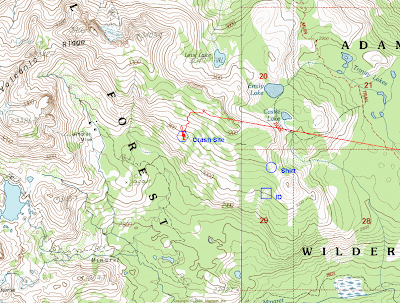The Recovery of Steve Fossett
 Thursday, October 9, 2008 at 17:00
Thursday, October 9, 2008 at 17:00  Jeff Lehman
Jeff Lehman My team was called to assist with the recovery effort at the scene of the Fossett aircraft crash. Our job was to grid search the area looking for remains. Also onsite was the NTSB who were investigating the reasons for the crash.
When the call came we were told that personal effects of Mr. Fossett were found, and that we were to look for the crash site. On our way to the command post at Mammoth Airport...
The Recovery of S. Fossett from SBSAR on Vimeo.
we received word that the crash site had been found, and that we were to be flown to the site in the morning to search for remains.
As it happens in SAR, the requested aircraft were not on scene in the morning, so instead of a ride to the search location, we had a 7 mile hike. As a search manager making the hike-in versus fly-in decision is always difficult. To keep searchers fresh, and to maximize daylight, it is better to fly to a location. If your aircraft are not on scene, then the manager needs to decide whether it is better to wait for the aircraft, or get folks moving on the ground. It isn't uncommon for teams to wait for the aircraft only to have them not show up. When this happens it sets everything back. In this case, the decision was made for us to begin hiking in.
After a 40 minute drive to the trailhead, more than 30 searchers hit the trail to the wreckage. The weather was cool, and a light rain was falling. Fortunately the rain didn't continue through the day, but bad weather was on the way.
Quickly the crew got spread out along the trail. Three of us from San Bernardino ended up together as we made our way toward a location where we would leave the trail and climb a hill to the crash site. We had a good map of the area and a GPS so the cross-country trip wasn't very difficult to navigate. We carefully flagged our route so that teams behind us could easily find the path. Once the route left the trail, it became very steep, so we were winded when we reached the top. It was there that we realized that we were the second crew in, about 10 minutes behind the leaders.
 From Fossett Recovery
From Fossett Recovery
Evidently the requested aircraft arrived in Mammoth, as the NTSB investigators had been flown in and were evaluating the scene when we arrived. The crash site was on a south-facing slope, and the debris field was a few hundred meters long by about 80 meters at its widest. It looked like the plane struck a rock outcrop and came to rest about 100 feet above that location. Debris was everywhere, and there were few large pieces. The largest piece was the engine, and it was a about 100 meters from what seemed to be to the initial impact area. There was evidence of fire in the area as a couple of trees were burned and there was charcoal on the ground.
After a few minutes of rest and refueling, we began the grid search. Together with with some folks from Inyo and Mono Counties, the three of us from San Bernardino County formed a line at the southern-most section of the debris field and grid searched a strip that ended when we passed the engine and saw no further debris. Grid searching is slow-going, so before our second pass was completed, more searchers had arrived, and we were able to spread the line a bit. In all we made three or four north-south passes and the same number of east-west passes over the same area. It is helpful to view things from different angles, so that is why we doubled our efforts in the perpendicular direction.We worked about an arm's length between searchers for a high probability of detection (POD).
After making our second search of the debris, word was passed that we were to be flown out and to make our way to the landing zone (LZ). The LZ was about a half kilometer east and uphill from the crash site. Part way up the climb I began to doubt whether the climb was worth a ride out, but daylight was running low and the search managers didn't want more searchers spread out on the trail.
We arrived at the LZ to find a National Guard blackhawk helicopter waiting for us. After making contact with the crew chief, three of us were waved aboard to join a few that were already belted in. After a few minutes in the air we touched down at the Mammoth airport and made our way to our debriefing.
What appeared to be a skull fragment was found, but whether it belongs to Mr. Fossett is still to be determined. For the family's sake, I hope that this will provide closure. I am continually amazed at the cooperation that occurs in events such as this. We regularly provide mutual aid to other counties (as they do for us), and it is always good to see familiar faces from other parts of the state. California is fortunate to have such an active, highly-trained cadre of search and rescue professionals.
 Missions
Missions 
Reader Comments